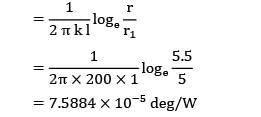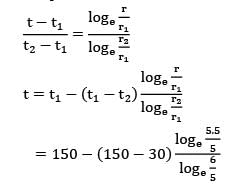Chemical Engineering Exam > Chemical Engineering Questions > Hot combustion gases at 150°C flow through a...
Start Learning for Free
Hot combustion gases at 150°C flow through a hollow cylindrical pipe of 10 cm inner diameter and 12 cm outer diameter. The pipe is located in a space at 30°C and the thermal conductivity of the pipe material is 200 W/m-K. Neglecting surface heat transfer coefficients, calculate the temperature at a point halfway between the inner and outer surface.
- a)87
- b)88
Correct answer is between '87,88'. Can you explain this answer?
| FREE This question is part of | Download PDF Attempt this Test |
Verified Answer
Hot combustion gases at 150°C flow through a hollow cylindrical pipe ...
In terms of geometrical parameters, thermal resistance of a cylindrical pipe is






View all questions of this test


Heat loss 


= 826674 W
Radius at halfway through the pipe wall,

Thermal resistance of cylindrical pipe up to its mid-plane

Since heat flow through each section is same

∴ Temperature at the midplane,
T = 150 - 826674 X 7.5884 X 10-5
= 87.27°C
Alternatively from the expression for temperature distribution

= 87.18°C
Most Upvoted Answer
Hot combustion gases at 150°C flow through a hollow cylindrical pipe ...
Given data:
- Temperature of hot combustion gases (T₁) = 150°C
- Temperature of surrounding space (T₂) = 30°C
- Inner diameter of the pipe (D₁) = 10 cm
- Outer diameter of the pipe (D₂) = 12 cm
- Thermal conductivity of the pipe material (k) = 200 W/m-K
Assumptions:
- Steady-state heat transfer
- One-dimensional heat conduction
- Negligible surface heat transfer coefficients
Approach:
To calculate the temperature at a point halfway between the inner and outer surface of the pipe, we can use the formula for radial heat conduction through a cylindrical wall:
q = (2πkL(T₁ - T₂))/(ln(D₂/D₁))
Where:
- q is the heat transfer rate per unit length of the pipe
- L is the length of the pipe
Calculations:
1. Convert the given temperatures from Celsius to Kelvin:
T₁ = 150 + 273.15 = 423.15 K
T₂ = 30 + 273.15 = 303.15 K
2. Calculate the average diameter of the pipe:
D_avg = (D₁ + D₂)/2
= (10 + 12)/2 cm
= 11 cm
= 0.11 m
3. Calculate the length of the pipe by assuming a suitable value or using additional information. Let's assume it to be 1 meter.
4. Substitute the values into the equation for q:
q = (2πkL(T₁ - T₂))/(ln(D₂/D₁))
= (2π * 200 * 1 * (423.15 - 303.15))/(ln(12/10))
≈ 90,866.17 W/m
5. Calculate the temperature at a point halfway between the inner and outer surface of the pipe:
q = (2πkL(T₁ - T))/(ln(D₂/D₁))
Rearranging the equation, we get:
T = T₁ - (q * ln(D₂/D₁))/(2πkL)
= 423.15 - (90,866.17 * ln(12/10))/(2π * 200 * 1)
Using a calculator, the temperature at a point halfway between the inner and outer surface of the pipe is approximately 87.89°C.
Answer:
The temperature at a point halfway between the inner and outer surface of the pipe is approximately 87.89°C.
- Temperature of hot combustion gases (T₁) = 150°C
- Temperature of surrounding space (T₂) = 30°C
- Inner diameter of the pipe (D₁) = 10 cm
- Outer diameter of the pipe (D₂) = 12 cm
- Thermal conductivity of the pipe material (k) = 200 W/m-K
Assumptions:
- Steady-state heat transfer
- One-dimensional heat conduction
- Negligible surface heat transfer coefficients
Approach:
To calculate the temperature at a point halfway between the inner and outer surface of the pipe, we can use the formula for radial heat conduction through a cylindrical wall:
q = (2πkL(T₁ - T₂))/(ln(D₂/D₁))
Where:
- q is the heat transfer rate per unit length of the pipe
- L is the length of the pipe
Calculations:
1. Convert the given temperatures from Celsius to Kelvin:
T₁ = 150 + 273.15 = 423.15 K
T₂ = 30 + 273.15 = 303.15 K
2. Calculate the average diameter of the pipe:
D_avg = (D₁ + D₂)/2
= (10 + 12)/2 cm
= 11 cm
= 0.11 m
3. Calculate the length of the pipe by assuming a suitable value or using additional information. Let's assume it to be 1 meter.
4. Substitute the values into the equation for q:
q = (2πkL(T₁ - T₂))/(ln(D₂/D₁))
= (2π * 200 * 1 * (423.15 - 303.15))/(ln(12/10))
≈ 90,866.17 W/m
5. Calculate the temperature at a point halfway between the inner and outer surface of the pipe:
q = (2πkL(T₁ - T))/(ln(D₂/D₁))
Rearranging the equation, we get:
T = T₁ - (q * ln(D₂/D₁))/(2πkL)
= 423.15 - (90,866.17 * ln(12/10))/(2π * 200 * 1)
Using a calculator, the temperature at a point halfway between the inner and outer surface of the pipe is approximately 87.89°C.
Answer:
The temperature at a point halfway between the inner and outer surface of the pipe is approximately 87.89°C.

|
Explore Courses for Chemical Engineering exam
|

|
Similar Chemical Engineering Doubts
Hot combustion gases at 150°C flow through a hollow cylindrical pipe of 10 cm inner diameter and 12 cm outer diameter. The pipe is located in a space at 30°C and the thermal conductivity of the pipe material is 200 W/m-K. Neglecting surface heat transfer coefficients, calculate the temperature at a point halfway between the inner and outer surface.a)87b)88Correct answer is between '87,88'. Can you explain this answer?
Question Description
Hot combustion gases at 150°C flow through a hollow cylindrical pipe of 10 cm inner diameter and 12 cm outer diameter. The pipe is located in a space at 30°C and the thermal conductivity of the pipe material is 200 W/m-K. Neglecting surface heat transfer coefficients, calculate the temperature at a point halfway between the inner and outer surface.a)87b)88Correct answer is between '87,88'. Can you explain this answer? for Chemical Engineering 2024 is part of Chemical Engineering preparation. The Question and answers have been prepared according to the Chemical Engineering exam syllabus. Information about Hot combustion gases at 150°C flow through a hollow cylindrical pipe of 10 cm inner diameter and 12 cm outer diameter. The pipe is located in a space at 30°C and the thermal conductivity of the pipe material is 200 W/m-K. Neglecting surface heat transfer coefficients, calculate the temperature at a point halfway between the inner and outer surface.a)87b)88Correct answer is between '87,88'. Can you explain this answer? covers all topics & solutions for Chemical Engineering 2024 Exam. Find important definitions, questions, meanings, examples, exercises and tests below for Hot combustion gases at 150°C flow through a hollow cylindrical pipe of 10 cm inner diameter and 12 cm outer diameter. The pipe is located in a space at 30°C and the thermal conductivity of the pipe material is 200 W/m-K. Neglecting surface heat transfer coefficients, calculate the temperature at a point halfway between the inner and outer surface.a)87b)88Correct answer is between '87,88'. Can you explain this answer?.
Hot combustion gases at 150°C flow through a hollow cylindrical pipe of 10 cm inner diameter and 12 cm outer diameter. The pipe is located in a space at 30°C and the thermal conductivity of the pipe material is 200 W/m-K. Neglecting surface heat transfer coefficients, calculate the temperature at a point halfway between the inner and outer surface.a)87b)88Correct answer is between '87,88'. Can you explain this answer? for Chemical Engineering 2024 is part of Chemical Engineering preparation. The Question and answers have been prepared according to the Chemical Engineering exam syllabus. Information about Hot combustion gases at 150°C flow through a hollow cylindrical pipe of 10 cm inner diameter and 12 cm outer diameter. The pipe is located in a space at 30°C and the thermal conductivity of the pipe material is 200 W/m-K. Neglecting surface heat transfer coefficients, calculate the temperature at a point halfway between the inner and outer surface.a)87b)88Correct answer is between '87,88'. Can you explain this answer? covers all topics & solutions for Chemical Engineering 2024 Exam. Find important definitions, questions, meanings, examples, exercises and tests below for Hot combustion gases at 150°C flow through a hollow cylindrical pipe of 10 cm inner diameter and 12 cm outer diameter. The pipe is located in a space at 30°C and the thermal conductivity of the pipe material is 200 W/m-K. Neglecting surface heat transfer coefficients, calculate the temperature at a point halfway between the inner and outer surface.a)87b)88Correct answer is between '87,88'. Can you explain this answer?.
Solutions for Hot combustion gases at 150°C flow through a hollow cylindrical pipe of 10 cm inner diameter and 12 cm outer diameter. The pipe is located in a space at 30°C and the thermal conductivity of the pipe material is 200 W/m-K. Neglecting surface heat transfer coefficients, calculate the temperature at a point halfway between the inner and outer surface.a)87b)88Correct answer is between '87,88'. Can you explain this answer? in English & in Hindi are available as part of our courses for Chemical Engineering.
Download more important topics, notes, lectures and mock test series for Chemical Engineering Exam by signing up for free.
Here you can find the meaning of Hot combustion gases at 150°C flow through a hollow cylindrical pipe of 10 cm inner diameter and 12 cm outer diameter. The pipe is located in a space at 30°C and the thermal conductivity of the pipe material is 200 W/m-K. Neglecting surface heat transfer coefficients, calculate the temperature at a point halfway between the inner and outer surface.a)87b)88Correct answer is between '87,88'. Can you explain this answer? defined & explained in the simplest way possible. Besides giving the explanation of
Hot combustion gases at 150°C flow through a hollow cylindrical pipe of 10 cm inner diameter and 12 cm outer diameter. The pipe is located in a space at 30°C and the thermal conductivity of the pipe material is 200 W/m-K. Neglecting surface heat transfer coefficients, calculate the temperature at a point halfway between the inner and outer surface.a)87b)88Correct answer is between '87,88'. Can you explain this answer?, a detailed solution for Hot combustion gases at 150°C flow through a hollow cylindrical pipe of 10 cm inner diameter and 12 cm outer diameter. The pipe is located in a space at 30°C and the thermal conductivity of the pipe material is 200 W/m-K. Neglecting surface heat transfer coefficients, calculate the temperature at a point halfway between the inner and outer surface.a)87b)88Correct answer is between '87,88'. Can you explain this answer? has been provided alongside types of Hot combustion gases at 150°C flow through a hollow cylindrical pipe of 10 cm inner diameter and 12 cm outer diameter. The pipe is located in a space at 30°C and the thermal conductivity of the pipe material is 200 W/m-K. Neglecting surface heat transfer coefficients, calculate the temperature at a point halfway between the inner and outer surface.a)87b)88Correct answer is between '87,88'. Can you explain this answer? theory, EduRev gives you an
ample number of questions to practice Hot combustion gases at 150°C flow through a hollow cylindrical pipe of 10 cm inner diameter and 12 cm outer diameter. The pipe is located in a space at 30°C and the thermal conductivity of the pipe material is 200 W/m-K. Neglecting surface heat transfer coefficients, calculate the temperature at a point halfway between the inner and outer surface.a)87b)88Correct answer is between '87,88'. Can you explain this answer? tests, examples and also practice Chemical Engineering tests.

|
Explore Courses for Chemical Engineering exam
|

|
Suggested Free Tests
Signup for Free!
Signup to see your scores go up within 7 days! Learn & Practice with 1000+ FREE Notes, Videos & Tests.


















